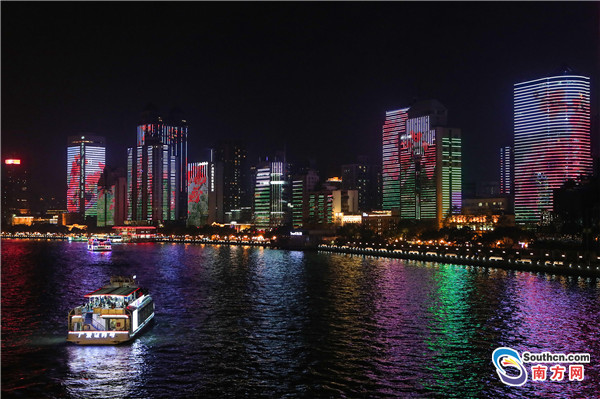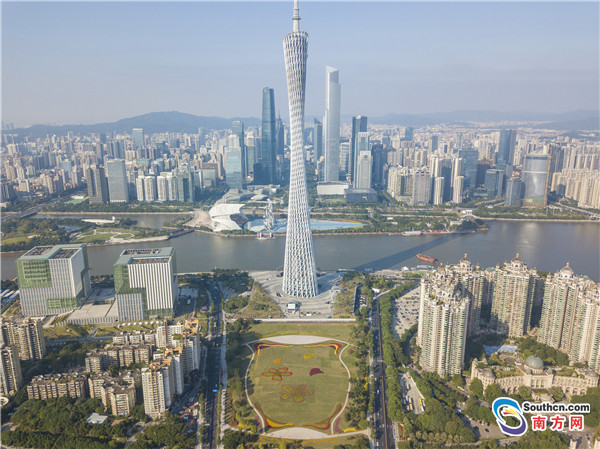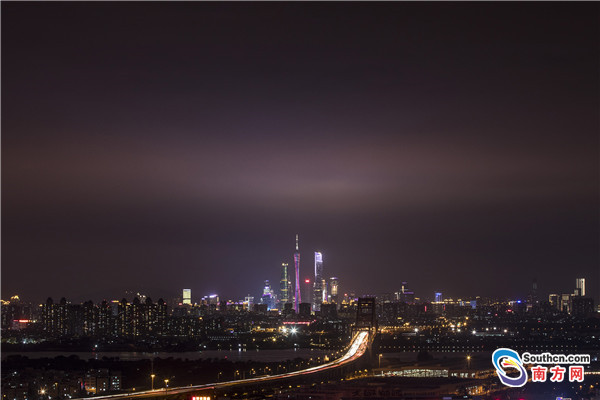“China will not close its door to the world; it will only become more and more open,” Chinese President Xi Jinping said at the 19th National Congress of the Communist Party of China in October, reaffirming China's commitment to its opening-up policy. As globalization faces uncertainties in many countries around the world, China has been championing international economic cooperation that is inclusive and universally beneficial.
Nowhere is the impact of the opening-up policy on economic development more evident than in Guangzhou, the capital city of Guangdong Province.
Guangzhou, known as the "Southern Gate of China," is speeding up its innovation and process of opening-up to the outside world. Here, an international city is emerging as a new hub of global integration.
Looking back at over 30 years of reform and opening-up, Guangzhou relies on openness to promote development and innovation, and has become an important transport hub, logistics center and trade center in Southern China. As a core area for attracting international capital, Guangzhou has been transforming itself from a millennia commercial city to a modern commercial center.
This year's Fortune Global Forum is taking place in Guangzhou. "Through the Fortune Global Forum which is 'the clearest and most direct window to the global economy,' we can see that Guangzhou is 'building itself as an important international exchange center' and that China is 'leading a new phase of globalization,'" said Alan Murray, president of Fortune and the chief content officer of Time Inc.
HUB AND GATEWAY TO THE WORLD
With a history of more than 2,200 years, Guangzhou is the birthplace of the ancient “Maritime Silk Road.” Known as the earliest foreign trade port and the only one that has never suspended operation in China, it has been dubbed the “millennial commercial city.” It is one of the major commercial centers where China first implemented its reform and opening-up policy.
In 2016, Guangzhou's gross domestic product (GDP) reached approximately RMB 1.96 trillion (USD 296 billion), exceeding the USD 20,000 per capita GDP and rivaling that of Singapore and neighboring Hong Kong. A total of 297 Fortune 500 companies have invested in Guangzhou.
Thanks to its industrial agglomeration, Guangzhou has continued to rank No.1 among pilot cities in cross-border e-commerce imports and exports since 2014. Between January and July 2017, the total value of Guangzhou's cross-border e-commerce worldwide trade in goods (import and export) amounted to RMB 12.48 billion (USD 1.89 billioin), 1.25 times higher than the previous year.
At the end of 2016, the United Nations released two reports that show Guangzhou is the world’s fastest growing mega-city and tops the list on the United Nations Development Programme's (UNDP) Human Development Index. In the Chinese Cities of Opportunities Report 2016 jointly released by PwC and the China Development Research Foundation, Guangzhou ranks at the top again.
According to China's Thirteenth Five-Year Plan, opening-up is a vital component for prosperity and development. Given increasing globalization and the upward trend of China's economy, Guangzhou is working to expand international cooperation, promoting a multi-dimensional and multi-tiered opening-up in a wide array of fields.
As a leading city of China's Belt and Road Initiative, Guangzhou boasts a world-class seaport, airport, rail transport and information hub. It has long gained access to the rest of the world through its 195 sea lanes and 304 domestic, international and regional air routes. In addition, 58 percent of Internet users in Mainland China access the World Wide Web via Guangzhou.
Helped by its strong transportation structure, Guangzhou is now working on its industry, innovation, talent and information networks in order to improve global travel and transportation, logistics, capital flow and communication.
The city is aiming to establish an international shipping center, logistics center, trade center, financial innovation service system, science and technology center, and high-end manufacturing base, engage in new city construction and develop itself into a comprehensive transportation hub.
FREE TRADE ZONE: NEW GATEWAY TO THE WORLD
Guangzhou led the nation during China's three decades of rapid growth. Now it has taken on the role of spearheading new reforms in its free trade zone, where local authorities have greater discretion to manage business activities and cross-border capital flow.
The China (Guangdong) Pilot Free Trade Zone (GDFTZ) was formally approved by the State Council and established on December 31, 2014. Bordering Hong Kong and Macao, the GDFTZ is designed to become a showroom for strong collaboration between Guangdong, Hong Kong and Macao, a crucial hub of the 21st Century Maritime Silk Road and a pilot area for the next round of economic reforms nationwide.
Since the Nansha Area in southeast Guangzhou became part of the GDFTZ two years ago, it has become a leading force in developing an essential opening-up platform to enhance Guangzhou’s role in the 21st Century Maritime Silk Road and the development of the Guangdong-Hong Kong-Macao Greater Bay Area.
Covering a total area of 60 square kilometers, Guangzhou's Nansha New Area is the largest of the three areas of the GDFTZ. It was set up to provide a conducive operational and tax environment for manufacturers as well as shipping companies. Nansha Area is spearheading structural reforms to make it easier to start businesses and grant foreign firms more access to the service sector.
In May 2017, China launched its first major cross-border experiential store in the Guangdong Free-Trade Zone's Nansha New Area. In this direct sales town, over 200,000 kinds of imported goods from other countries and regions are sold, making it another platform that enables customers to buy imported goods from around the world. The terms of trade of national market purchase, officially piloted in Guangzhou, provide favorable customs clearance procedures, making exporting goods from the Pearl River Delta (aka the "World's Renowned Manufacturing Area") much easier and more efficient for business owners.
Nansha will “endeavor to establish a new high-level open economic system, be a pilot free trade zone with legal environmental norms in line with high international standards, investment and trade facilitation," according to the general goals outlined in its official construction plan.
With a market-oriented business environment, broader access for foreign investment, and favorable policies to facilitate innovation, Nansha is attracting an increasing number of multinationals to set up businesses.
GAC Toyota Motor Co., Ltd., a joint venture between Toyota Motor and China's GAC Group, is building a 406-million-U.S.-dollar plant in Nansha that is expected to be put into operation by the end of 2017.
“Infrastructure is key for us to have a good operation. I believe that with Nansha's development, we can enjoy better infrastructure,” said Kazuhiro Kobayashi, president of GAC Toyota.
By 2016, the import and export volume of Nansha reached nearly RMB 170 billion (24.66 billion dollars), one fifth of Guangzhou's total.
Statistics showed that 92 of the Fortune 500 companies have invested in Nansha and 103 corporate headquarters have been based in the district, helping it lead the GDP growth rate in Guangzhou for 14 consecutive months.
Relying on the Nansha, Guangzhou is actively exploring the establishment of institutional mechanisms, which would link it up with international investment trade rules. The district will also help Guangzhou realize its goals in the Thirteenth Five-Year Plan to build an international trade center by 2020, which would drive the development of southern China, serve the nation, spread out along the “Belt and Road,” connect the globe, boast strong capacity for growth, be competitive and have a good reputation.
GREATER REGIONAL INTEGRATION
The development of the Guangdong-Hong Kong-Macao Greater Bay Area will gain further impetus after President Xi pledged to give priority to the regional cooperation initiative in his report to the 19th National Congress of the CPC.
The Guangdong-Hong Kong-Macao region has all the necessary requirements for a super city cluster to develop successfully. These include wonderful deep-water harbors, mighty innovation hubs, sophisticated financial markets, transportation hubs as well as a huge pool of talent. Guangzhou has been leveraging its proximity to Hong Kong and Macao to encourage closer cooperation.
“Based in Guangzhou, depending on the Pearl River Delta, connecting Hong Kong and Macao, serving the Chinese mainland and aiming for the world, Nansha Area of GDFTZ shall become a demonstration zone for overall cooperation among Guangdong, Hong Kong and Macao, and contribute more to the transformation and upgrading of the Pearl River Delta, improving the long-term prosperity and stability of Hong Kong and Macao, and establishing the opening-up of the economic structure of our country,” according to the White Paper on the Guangzhou Investment Environment 2016 published by the local government.
The GDFTZ has already become a popular destination for Hong Kong companies as government data show about 4,700 Hong Kong invested firms have entered the three GDFTZ areas of Nansha, Qianhai and Shekou, and Hengqin.
Experience in the past two years has shown that GDFTZ plays an important role in facilitating Hong Kong in its economic restructuring, according to analysts.
With a theme of comprehensive cooperation among Guangdong-Hong Kong-Macao, Guangzhou has been enhancing regional cooperation and boosting interactive exchanges between governments, non-governmental organizations, trade associations and enterprises between Guangdong, Hong Kong and Macao.
PEARL ON MARITIME SILK ROAD
Being in the vanguard of reform and opening-up for decades, Guangzhou has been a leading force in promoting the Belt and Road Initiative, which comprises the Silk Road Economic Belt and the 21st Century Maritime Silk Road designed to build a trade and infrastructure network connecting Asia with Europe, Africa and beyond.
Guangzhou is transforming itself into a strategic hub as part of the Belt and Road Initiative, and practical cooperation with important ports of countries along the Maritime Silk Road is being promoted.
To enhance Guangzhou’s role in the 21st Century Maritime Silk Road that is part of the Belt and Road Initiative, Nansha Port has been establishing a port-alliance with the countries along the 21st Century Maritime Silk Road and collecting funds for the construction of ports on the Maritime Silk Road.
Facilitated by the Belt and Road Initiative, Nansha Area has been stepping up efforts to upgrade its industrial structure, trade and business environments, and transportation facilities, to best combine Guangzhou’s traditional advantages with new opportunities.
“Fully meeting with the initiative of ‘Belt and Road,’ Nansha Area shall set up an investment promotion system closely connected with the global new technology and industrial development trend,” said the White Paper on Guangzhou Investment Environment 2016.
Through developing itself into an essential platform, Guangzhou aims to further open itself up globally, and build a new high-level open economic system.
A strategic hub city will be developed as an effort to achieve the goals of the Belt and Road Initiative, according to goals set by the local government. Cooperation with important ports of countries along the Maritime Silk Road will be promoted. Efforts will be made to put the Guangzhou-Xinjiang-Europe international railway into service. With the implementation of the “Sister Cities along the Maritime Silk Road” strategy, vigorous efforts will be made in the industrial, trade, tourist cooperation and cultural exchanges.
"The Belt and Road Initiative has injected new impetus into the economic and trade exchanges between Guangzhou and foreign cities," said Luo Zheng, director of the Comprehensive Division of the Commission of Commerce of the Guangzhou municipal government.
The city currently focuses on creating a market-oriented, law-based and internationalized business environment and continues to enhance the level of trade and investment facilitation. What's more, the government continues to strengthen its reform of streamlining procedures, and offering fairer regulations and highly effective service. A total of 176 items were streamlined in 2016 as new administrative approval procedures were introduced.
Nina Easton, co-chair of the Fortune Global Forum, said that Guangzhou’s policies on facilitating foreign investment and trade, its strategic position on the 21st Century Maritime Silk Road, as well as the city’s development of the GDFTZ have all contributed to its great attraction for multinational companies.
By 2020, Guangzhou is set to become both a domestic and foreign trade center that leads the development of southern China, serves the nation, promotes the Belt and Road Initiative, connects the globe, and boasts a strong capacity for cluster and radiation.
As China’s Southern Gate to the world and a national leader in promoting the country's opening-up policy, the millennia commercial city of Guangzhou will continue its role as a vanguard in championing China’s international cooperation and globalization in the new era. (End)



















